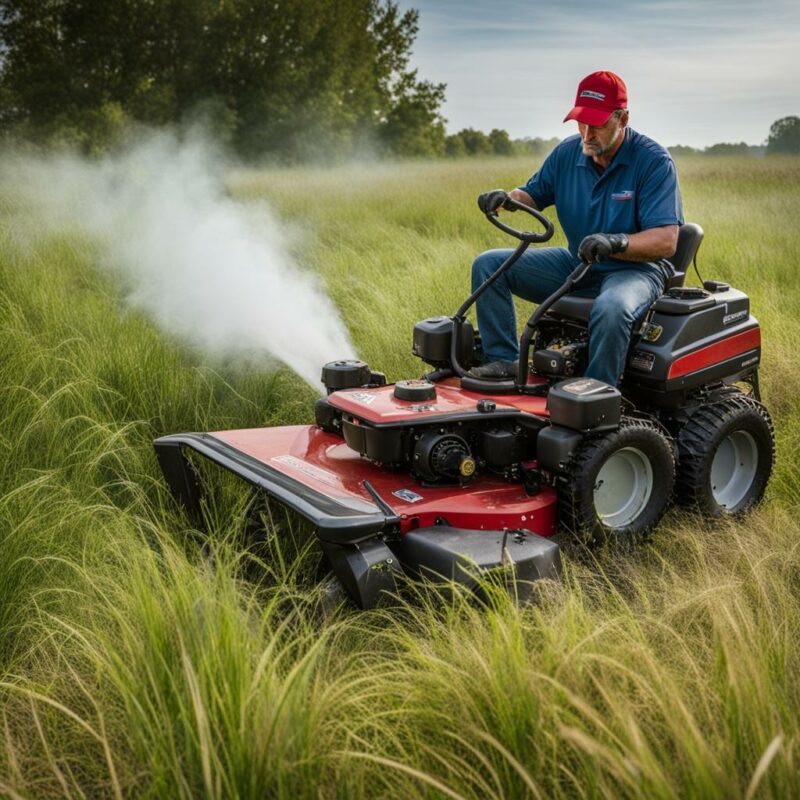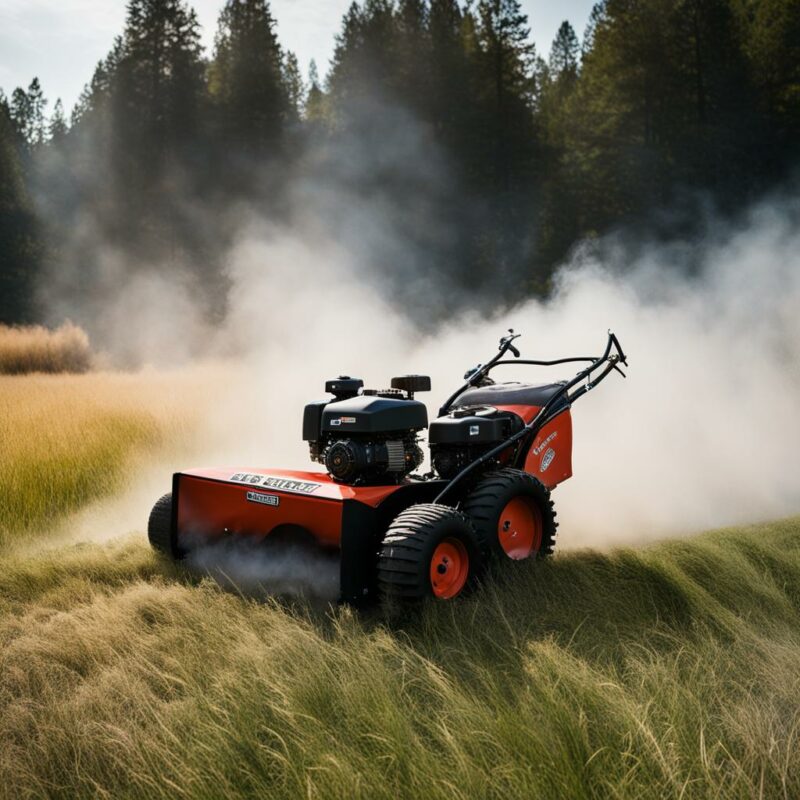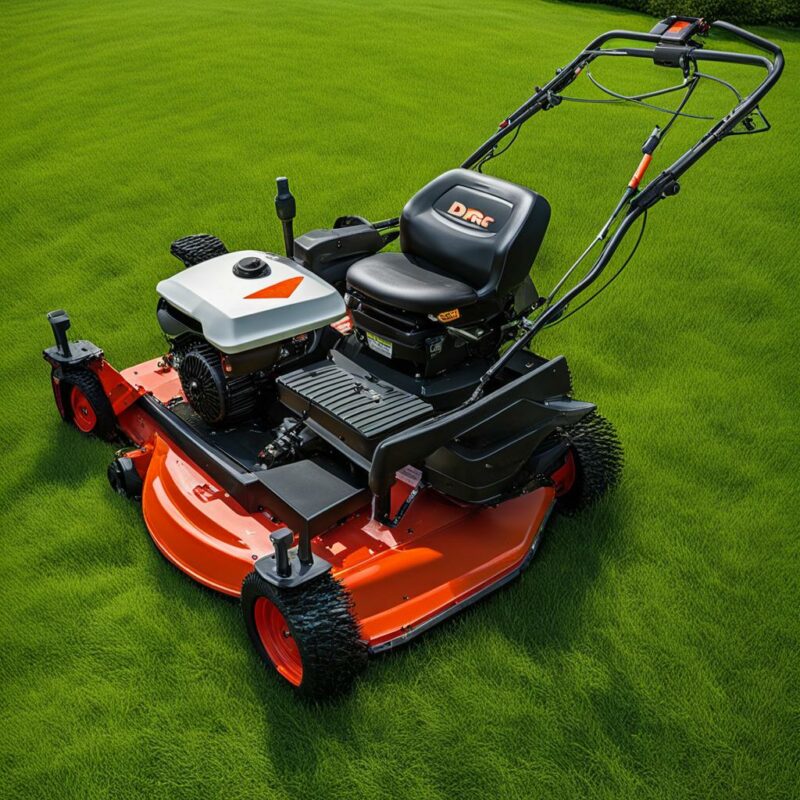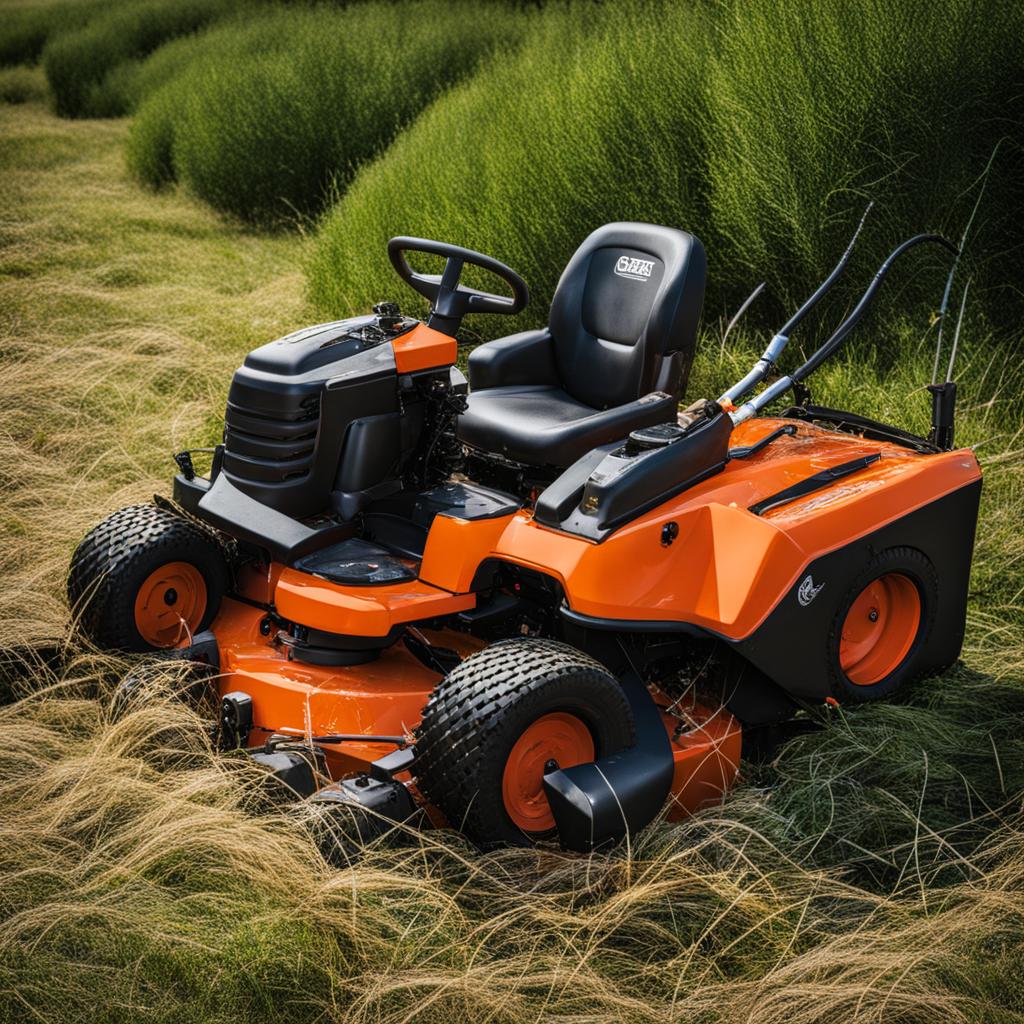DR brush mowers are popular, but they come with their fair share of problems. Common issues reported by customers include stalling engines, uneven cuts, difficulty starting, power loss, and more. This article will explore these common problems and provide effective solutions for troubleshooting them. By properly maintaining certain components and implementing the suggested solutions, you can keep your DR brush mower working at peak performance.
Key Takeaways:
- DR brush mowers can experience problems such as stalling engines, uneven cuts, difficulty starting, and power loss.
- Proper maintenance and troubleshooting can help resolve these common problems.
- Check spark plugs, fuel level, air filters, carburetors, and other components for issues.
- Engine overheating can be prevented by maintaining proper oil levels and keeping cooling systems clean.
- Blade and cutting issues can be resolved by checking bolts, blade sharpness, deck height, and mower speed.
Starting Issues
One common problem with DR brush mowers is difficulty starting the engine. There are several potential culprits for this issue. Start by checking the spark plugs and ensuring the spark plug wires are properly attached. Dirty spark plugs can be cleaned with fine emery paper. Additionally, check the fuel level and change the gas if it is old or add fuel stabilizer if the gas will be stored for over a month. Clogged air filters or carburetors can also impede fuel flow to the engine, so clean or replace them if necessary. Lastly, check the batteries, fuses, and wiring connections for any issues.
As seen in Table 1 below, troubleshooting starting issues on a DR brush mower is a step-by-step process. By checking and addressing each potential cause, you can identify and resolve the problem effectively.
| Cause | Solution |
|---|---|
| Dirty spark plugs | Clean with fine emery paper |
| Old or contaminated gas | Change the gas or add fuel stabilizer |
| Clogged air filters or carburetors | Clean or replace |
| Issues with batteries, fuses, or wiring connections | Check and address any problems |
It’s important to address starting issues promptly to ensure optimal performance from your DR brush mower. By following the troubleshooting steps and implementing the suggested solutions, you can overcome starting problems and get back to tackling your outdoor tasks with ease.
Solutions for DR Brush Mower Power Loss
If you’re experiencing power loss with your DR brush mower, there are several troubleshooting steps you can take to address the issue. By identifying and resolving the underlying causes, you can restore your mower’s performance and ensure efficient cutting.
Check Fuel Level and Quality
One common reason for power loss is insufficient fuel in the tank. Start by checking the fuel level and filling it up if necessary. Additionally, consider the quality of the fuel. Stale or contaminated fuel can affect the engine’s performance. If the fuel is old, it’s best to drain and replace it with fresh fuel. Adding a fuel stabilizer can help prevent fuel degradation if the mower will be stored for an extended period.
Inspect and Clean Air Filters
Clogged air filters can restrict airflow to the engine, leading to power loss. Remove the air filter and inspect it for debris or dirt buildup. If it’s dirty, clean it or replace it with a new one. Regularly maintaining clean air filters will help optimize your mower’s performance.
Check Spark Plugs and Ignition System
Malfunctioning spark plugs or ignition systems can also contribute to power loss. Inspect the spark plugs for signs of damage or fouling. If they appear worn out or dirty, replace them with new ones. Additionally, check the ignition coil and connections to ensure they are secure and functioning correctly.
| Problem | Possible Causes | Solutions |
|---|---|---|
| Power Loss | Insufficient fuel, dirty air filters, faulty spark plugs | Check fuel level and quality, clean or replace air filters, inspect and replace spark plugs if necessary |
| Engine Stalling | Clogged carburetor, stale fuel, fouled spark plugs | Clean or replace carburetor, use fresh fuel, replace spark plugs |
| Uneven Cuts | Incorrect mower deck height, dull or worn blades | Adjust deck height, replace blades if needed |
By following these troubleshooting steps, you can effectively address power loss issues with your DR brush mower. Regular maintenance and proactive measures will help keep your mower running at its best, ensuring optimal cutting performance.

Engine Stalling
One of the common problems that DR brush mower owners may encounter is excessive engine stalling during mowing sessions. Engine stalling can be frustrating and disrupt the mowing process. Fortunately, there are several troubleshooting steps and solutions that can help resolve this issue.
One potential cause of engine stalling is a clogged or damaged carburetor. The carburetor plays a crucial role in mixing fuel and air for combustion. If it becomes clogged or damaged, it can disrupt the fuel flow to the engine and result in stalling. In such cases, it may be necessary to clean or replace the carburetor to ensure proper functioning.
Another factor to consider is the fuel quality. Stale or contaminated fuel can also lead to engine stalling. If the fuel is old or has been sitting for a long time, it is advisable to replace it with fresh fuel. Additionally, fouled spark plugs can contribute to stalling. Inspecting and replacing spark plugs when necessary can help maintain a steady engine performance.
“Proper maintenance and regular inspection of the carburetor, fuel quality, and spark plugs can help prevent engine stalling issues with your DR brush mower.”
| Problem | Cause | Solution |
|---|---|---|
| Engine Stalling | Clogged or damaged carburetor | Clean or replace the carburetor |
| Stale or contaminated fuel | Replace with fresh fuel | |
| Fouled spark plugs | Inspect and replace when necessary |
The table above summarizes the possible causes and solutions for engine stalling issues with DR brush mowers. By addressing these factors and performing regular maintenance, you can help prevent engine stalling and ensure smooth operation of your brush mower.
Engine Overheating
Engine overheating is a common issue that can lead to various other problems in DR brush mowers. It can be caused by several factors, including low oil level, blocked cooling fans, clogged air filters, and dirty decks. To prevent engine overheating, it’s important to regularly check and maintain the proper oil level. Additionally, ensure that the cooling fins, air filters, and deck are kept clean and free from debris. Avoid overloading the mower by refraining from mowing wet or thick grass for extended periods, as this can contribute to overheating.
If you encounter engine overheating issues with your DR brush mower, there are several troubleshooting steps you can take. Start by checking the oil level and adding more if necessary. Clean or replace the air filters to ensure proper airflow to the engine. Inspect the cooling fins and clean them thoroughly to prevent any blockages. It’s also important to avoid excessive strain on the mower by not overloading it with heavy grass or operating it on steep slopes.
Here is a table summarizing the common causes of engine overheating in DR brush mowers and possible solutions:
| Cause | Solution |
|---|---|
| Low oil level | Regularly check and maintain the proper oil level |
| Blocked cooling fans | Inspect and clean the cooling fans to ensure proper airflow |
| Clogged air filters | Clean or replace the air filters to ensure proper airflow |
| Dirty deck | Clean the deck to remove any debris that may obstruct airflow |
| Overloading the mower | Avoid mowing heavy grass or operating on steep slopes for extended periods |
By following these troubleshooting steps and implementing the suggested solutions, you can effectively address engine overheating issues in your DR brush mower, ensuring optimal performance and longevity.

Engine Smoking
One of the issues that DR brush mower owners may encounter is engine smoking. Occasional smoke coming from a DR brush mower can indicate fuel level issues. It’s important to adjust the fuel level according to the manufacturer’s recommendation to prevent excessive smoke. Additionally, a clogged air filter or the use of the wrong type of fuel can also cause smoke. Cleaning the cooling fins and carburetor thoroughly if they are dirty can help resolve this problem. It’s worth noting that operating the mower on slopes or uneven terrains beyond its capabilities can also lead to engine smoking.
“Regular maintenance and adhering to the manufacturer’s guidelines for fuel type and fuel level can significantly reduce the occurrence of engine smoking.”
If you’re experiencing engine smoking with your DR brush mower, troubleshooting the root cause is essential. By taking the necessary steps to adjust the fuel level, clean the air filter and carburetor, and operating the mower within its limitations, you can minimize engine smoking and ensure optimal performance.
Common Causes and Solutions for Engine Smoking
| Common Causes | Solutions |
|---|---|
| Incorrect fuel level | Adjust the fuel level according to the manufacturer’s recommendation |
| Clogged air filter | Clean or replace the air filter |
| Use of wrong fuel type | Ensure you are using the correct fuel type recommended by the manufacturer |
| Dirty cooling fins and carburetor | Clean the cooling fins and carburetor thoroughly |
| Operating the mower on slopes or uneven terrains beyond its capabilities | Mow on even terrain and avoid slopes that exceed the mower’s capabilities |
Following these troubleshooting steps and regular maintenance practices can help resolve engine smoking issues with your DR brush mower. However, if the problem persists or if you encounter any other unfamiliar problems, it is recommended to seek professional assistance for further diagnosis and repair.

Blade Doesn’t Cut Grass
If you’re facing the problem of your DR brush mower’s blade not cutting grass effectively, there are several troubleshooting steps you can take to resolve this issue. One common cause is loose mounting bolts that hold the blade in place. Check these bolts and tighten them if necessary to ensure a secure fit.
| Cause | Solution |
|---|---|
| Dull or Worn Blades | Replace the blades with sharp ones to ensure proper cutting. |
| Clogged Cutting Deck | Clean the cutting deck thoroughly to remove any debris or grass clippings that may be obstructing the blade. |
| Incorrect Mower Deck Height | Adjust the mower deck height according to the recommended settings to achieve the desired cutting results. |
| Excessive Speed | Reduce the speed at which you are mowing to allow the blades to properly cut the grass. |
By addressing these factors, you can improve the cutting performance of your DR brush mower and achieve a more even and efficient cut. Regular maintenance, such as blade sharpening and deck cleaning, is also essential to ensure optimal cutting results.

Customer Feedback:
“I had issues with my DR brush mower’s blade not cutting efficiently. After tightening the mounting bolts and cleaning the cutting deck, the problem was resolved. Now, I get a clean and precise cut every time!” – Mark, DR brush mower owner
Solutions for DR Brush Mower Uneven Cuts
Uneven cuts can be frustrating when using your DR brush mower, but there are several solutions to help you achieve a more even and professional-looking lawn. By addressing the following factors, you can improve the cutting performance of your mower and achieve the desired results.
1. Mower Deck Height Adjustment: One of the most common causes of uneven cuts is an incorrect mower deck height. Ensure that the mower deck is set to the appropriate height for the type of grass you are mowing. Different grass species have different recommended cutting heights, so refer to your mower’s manual or research the ideal height for your particular grass type.
2. Tire Pressure: Incorrect tire pressure can also contribute to uneven cuts. Check the tire pressure regularly and ensure that it is within the recommended range specified by the manufacturer. Properly inflated tires will provide better traction and help the mower maintain a consistent cutting height, resulting in more even cuts.
3. Blade Condition: Dull or worn blades can cause uneven cuts by tearing or ripping the grass instead of cleanly cutting it. Inspect the blades regularly and sharpen or replace them as needed. Sharp blades will ensure a clean and even cut, improving the overall appearance of your lawn.
4. Mowing Speed: The speed at which you mow can also affect the cutting performance. Mowing too quickly can result in missed spots and uneven cuts. Slow down and maintain a consistent speed while mowing to ensure that the blades have enough time to cut the grass evenly.
By implementing these solutions, you can overcome the problem of uneven cuts with your DR brush mower. Remember to regularly maintain and inspect your mower to ensure optimal performance and a well-manicured lawn.
Table: Recommended Cutting Heights for Common Grass Species
| Grass Species | Cutting Height (inches) |
|---|---|
| Bermuda Grass | 0.5 – 1.5 |
| Fescue Grass | 2.5 – 4 |
| Zoysia Grass | 1 – 2 |
| St. Augustine Grass | 3 – 4 |
Are DR Brush Mowers Worth It?
When considering purchasing a DR brush mower, many people wonder, are they any good? To answer this question, it’s important to weigh the pros and cons of these mowers and consider user reviews.
Pros of DR Brush Mowers:
- Lightweight and easy to maneuver
- Effective at handling tough vegetation, including saplings
- Affordable price compared to other brush mowers
- Quality components that ensure durability
Cons of DR Brush Mowers:
- Durability of engines can sometimes be a concern
- Availability of replacement parts may be limited
“I love my DR brush mower! It’s lightweight and makes clearing brush a breeze. The price was very reasonable, and the quality is great. I highly recommend it!” – Happy DR brush mower user
Ultimately, whether a DR brush mower is worth it or not depends on your individual needs and preferences. If you have a lot of tough vegetation to clear and want an affordable and lightweight option, a DR brush mower may be a great choice. However, if you prioritize long-term durability and easy access to replacement parts, you may want to consider other brands.
Before making a purchasing decision, it’s always a good idea to read reviews from other users and gather as much information as possible. This way, you can make an informed choice that aligns with your specific needs and expectations.
Table: Pros and Cons of DR Brush Mowers
| Pros | Cons |
|---|---|
| Lightweight and easy to maneuver | Durability of engines can sometimes be a concern |
| Effective at handling tough vegetation, including saplings | Availability of replacement parts may be limited |
| Affordable price compared to other brush mowers | |
| Quality components that ensure durability |
Conclusion
In conclusion, DR brush mowers may experience common problems, but these issues can be effectively resolved with proper maintenance and troubleshooting. By addressing starting issues, power loss, engine stalling, overheating, and other common problems, you can ensure that your DR brush mower continues to work efficiently.
To resolve starting problems, check the spark plugs, fuel level, air filters, and carburetors. Maintaining a clean fuel system and ensuring adequate airflow can help troubleshoot power loss issues. Excessive engine stalling can be resolved by inspecting and cleaning the carburetor, spark plugs, and fuel. Prevent engine overheating by maintaining the proper oil level and avoiding overloading the mower. Smoke issues can be resolved by adjusting fuel levels and cleaning the air filter and carburetor.
If your DR brush mower is not cutting grass effectively or providing uneven cuts, check the blade mounting bolts, blade condition, mower deck height, and tire pressure. Adjusting these factors can help achieve a more desired cutting performance.
Ultimately, the worth of a DR brush mower depends on individual needs and preferences. While some users appreciate their lightweight nature and ability to handle tough tasks, others have concerns about engine durability and part availability. By considering all factors and reading reviews, you can make an informed decision before purchasing a DR brush mower.
FAQ
What are some common issues with DR brush mowers?
Common issues reported by customers include stalling engines, uneven cuts, difficulty starting, power loss, and more.
How can I troubleshoot starting issues with my DR brush mower?
Check the spark plugs, fuel level, air filters, carburetors, batteries, fuses, and wiring connections. Clean or replace components if necessary.
What can cause power loss in a DR brush mower?
Insufficient fuel level, overheating, clogged fuel injectors or air filters, and damaged spark plugs or ignition coil can contribute to power loss.
What should I do if my DR brush mower keeps stalling while mowing?
Check the carburetor for clogs or damage, replace stale fuel and fouled spark plugs if necessary, and adjust mowing speed and cutting height.
How can I prevent engine overheating in my DR brush mower?
Maintain proper oil level, clean cooling fans, air filters, and deck, avoid overloading the mower, and refrain from mowing wet or thick grass for extended periods.
Why is my DR brush mower smoke coming from the engine?
Smoke can indicate fuel level issues, clogged air filters or carburetors, or operating the mower beyond its capabilities on slopes or uneven terrains.
What can I do if the blade on my DR brush mower is not cutting grass effectively?
Check and tighten the mounting bolts, replace dull or worn blades, and address factors like a clogged cutting deck, incorrect deck height, or excessive speed.
How can I achieve more even cuts with my DR brush mower?
Adjust the mower deck height, ensure proper tire pressure, and consider the speed of the mower and condition of the blades.
Are DR brush mowers worth it?
Reviews of DR brush mowers are mixed, with some praising their lightweight and affordable nature, while others express dissatisfaction with the durability of the engines and availability of replacement parts. It ultimately depends on individual needs and preferences.


